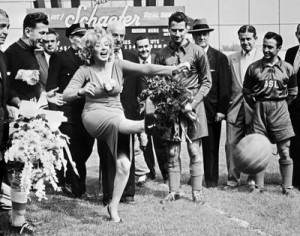When Soccer Was An Immigrant’s Game
The sight of Marilyn Monroe kicking a soccer ball caught my eye. This photograph, credited to AFP, accompanied a Yahoo News story about the 50th anniversary of her death, which occurred on August 5, 1962. In the shot, the Hollywood star performs the ceremonial first kick prior to a contest between the Hapoel club of Israel and the All-Stars US team. The match took place at Brooklyn’s Ebbets Field, in 1957.
The thought of Marilyn in the proximity of a soccer game strained my imagination. What did she know about the sport? What did her ex-husband, baseball legend Joe DiMaggio, think about her presence there? More importantly, what was filmdom’s most renowned celebrity doing at an event where most of the people in the stands, as well as many of the players, were recent immigrants to the United States?
When my attention drifted beyond the image of Marilyn, the men surrounding her drew me in further. The players, their uniforms, the grainy feel of that era transported me back to my Los Angeles childhood—a childhood that included attending countless soccer matches.
My father, an immigrant, was born in Nicaragua. He spent his adolescence, however, in Panama. Although baseball was the reigning sport in both countries, in Nicaragua he attended a Catholic school where the priests—most of them Europeans, from Italy and Spain—fomented an almost spiritual devotion to soccer among their students.
A fan of baseball, basketball, and soccer, my father attended as many games as possible—always with me in tow. For his baseball cravings, we went to Dodger games—first at the Memorial Coliseum, and then at Dodger Stadium. For his basketball fixes, we frequented the LA Sport Arena to watch the Lakers. And for his devotion to soccer . . . we drove to the handful of public parks that had soccer fields to catch games from the Greater Los Angeles Soccer League—an organization formed by amateurs who were passionate about football.
A mere glance at a few of the team names gives a clear indication of the league’s cultural diversity: the L.A. Scots, the Danish-Americans, the Los Angeles Saprissa, the San Pedro Yugoslavs, the Los Angeles Armenians, and the Pan-American Soccer Club. My father’s favorite team was the L.A. Kickers. Originally comprised of German immigrants, the Kickers began the practice of recruiting the best amateur talent—regardless of national origin or ethnicity—and in doing so, they built a dynasty that won the state title for seven consecutive years.
This took place, of course, before the advent of youth soccer leagues, which have been instrumental in introducing the sport to new generations of Americans. Back then, however, the players and fans were, almost in their entirety, immigrants. At the games, the vibrant spectrum of languages fascinated me, with English—spoken in a colorful array of accents—serving as the lingua franca for folks who wished to communicate across cheering sections.
The majority of those in attendance were there to enjoy a respite from the stress of having to adjust to life in their new homeland. For the crowd, those soccer weekends were comfortable and familiar. Those outings also provided the unifying experience of sharing their enthusiasm for a game that transcended national, ethnic, religious, and linguistic boundaries.
Marilyn Monroe may have noted the respect that fans had for “the other” on that day. She may have seen that what divided them was insignificant at such events. And she may have even marveled that a sport of immigrants could bring people together not only as fans, but also as new Americans.
Silvio Sirias is the author of Bernardo and the Virgin and Meet Me under the Ceiba, two novels set in Nicaragua. He lives and writes in Panama. For more information, visit his website atwww.silviosirias.com
[Photo by AFP/Yahoo News]

